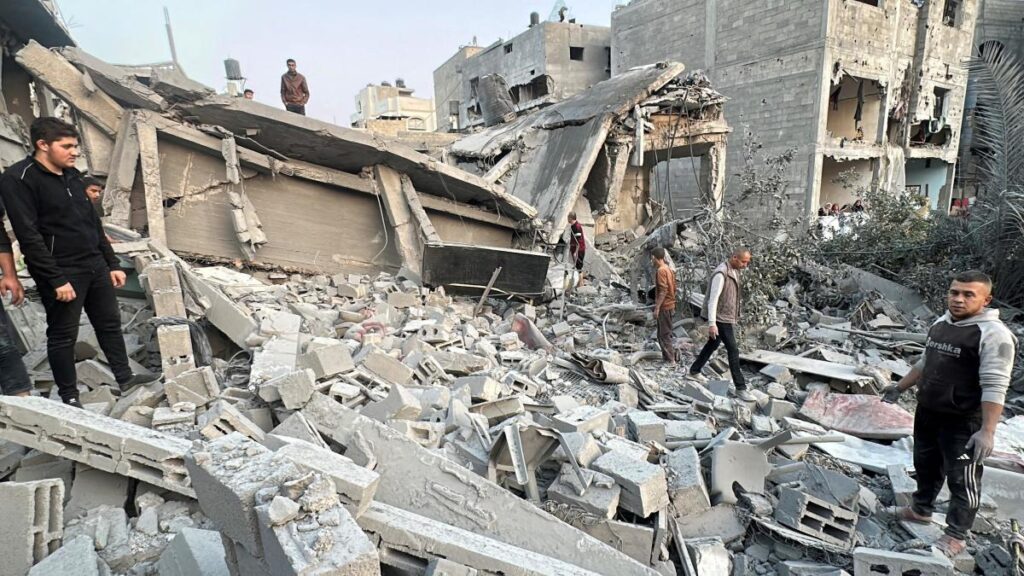The ongoing conflict in Gaza has escalated, culminating in a devastating Israeli airstrike on a residence in Jabalia that has resulted in significant casualties. According to Palestinian medical personnel, at least 30 individuals have been reported killed, among them 13 children. The strike has prompted widespread condemnation and cries for justice from the local population, who insist that the victims were not associated with any military factions. Eyewitness accounts depict the scene as one of horror, likening the blast to an “earthquake,” with many inhabitants caught unaware as the building collapsed around them. The Israeli Defense Forces (IDF) stated that the strike targeted a site where Hamas operatives were believed to be active, while they claim efforts were made to minimize civilian harm during the operation. This tragic incident is part of a larger context in which Jabalia and other northern Gaza locations have faced relentless attacks since early October, following Israel’s intensified military campaign following a Hamas assault that left significant Israeli casualties.
The humanitarian conditions in Gaza have reached a critical point, with international organizations expressing urgent concern over the impending famine. Aid groups, witnessing the devastation firsthand, describe a humanitarian crisis that has been exacerbated by ongoing conflict and blockades. Currently, the Biden administration has put pressure on Israel to improve conditions for civilians in Gaza, threatening to impose limits on military cooperation if significant progress is not made towards alleviating the suffering of the population. Dr. Fadel Naim, from a local hospital, confirmed the receipt of multiple bodies from the Jabalia strike, indicating that the toll may surpass initial estimates. Witnesses to the strikes have recounted the harrowing and chaotic aftermath, as countless victims have been pulled from the debris, their lives shattered in an instant. The lack of independent media access to Gaza complicates efforts to verify claims from both sides, leading to an overwhelming reliance on local testimonies and available footage.
This recent escalation follows a series of violent outbreaks resulting from the October 7 Hamas attack, which killed around 1,200 Israelis and unleashed an ongoing cycle of violence wherein more than 43,600 Gazans reportedly have succumbed to the conflict according to Hamas’s health ministry. International reactions have varied—some world leaders condemn the excessive use of force by Israel, while others affirm the right of the Israeli state to defend itself against attacks from Hamas and other militant groups. Many observers remain deeply concerned about the humanitarian crisis unfolding in Gaza, particularly with regards to the high civilian casualty rate. It is reported that a significant percentage of the deceased in recent months have been women and children, raising alarms about potential violations of human rights and international law.
In the face of worsening conditions, the international community is urging immediate solutions and a potential reprieve or ceasefire in hostilities. The UN’s Human Rights Office has highlighted the alarming statistics regarding civilian deaths in Gaza, attributing the toll to Israel’s deployment of weapons that have widespread effects in densely populated urban areas. The UN estimates suggest that around 80% of those killed were in residential structures, often due to indiscriminate attacks. Israel, on the other hand, defends its military operations by asserting that it primarily targets Hamas militants and uses precision weapons whenever possible to reduce collateral damage. Nevertheless, the feverish pace of deaths and destruction prompts growing demands for accountability and transparency in military actions.
Despite international calls for cessation of violence, diplomatic efforts toward a ceasefire remain stagnant. Qatar has recently decided to withdraw as a mediator, underscoring the complexities involved in negotiating peace between the two warring parties. Both Hamas and the Israeli government appear entrenched in their positions, leading to continued conflict and bloodshed. The prospect of negotiating a ceasefire or finding a resolution to the war seems increasingly difficult as each side remains firm in its objectives and unwilling to make concessions. The breakdown of mediation talks showcases the broader challenges to achieving lasting peace in the region, particularly given the profound mistrust and rival narratives that have developed through decades of hostilities.
With mounting pressure from both domestic and international fronts, the potential for escalation remains high. As the death toll rises and humanitarian conditions deteriorate, global leaders face the challenge of addressing the conflict without inflaming further tensions. The situation in Gaza is emblematic of broader geopolitical tensions in the Middle East, with implications that extend beyond the immediate conflict. The mix of traditional warfare and modern political dynamics, intertwined with historical grievances, complicates any attempt to forge a sustainable pathway to peace. The response by nations around the world, including humanitarian aid and rhetoric against violence, underscores the global implications of such conflicts as they strive to resolve the pressing humanitarian crisis at hand.
In conclusion, the war in Gaza continues to evoke deep emotions and urgent calls for action from the international community amidst unprecedented suffering. The Israeli airstrike in Jabalia is merely one tragic illustration of the broader conflict that plagues the region, as civilians bear the brunt of escalating violence. The urgent need for a humanitarian response is clear, but without a concerted effort towards strategic negotiations, lasting peace remains elusive. The complexity of this crisis necessitates a nuanced understanding of the underlying issues at play, as well as a commitment to finding paths for dialogue that prioritize the protection of innocent lives in the face of ongoing hostilities. With the humanitarian clock ticking, the international community’s response could shape the trajectory of the conflict and the future of Gaza’s ever-volatile landscape.

